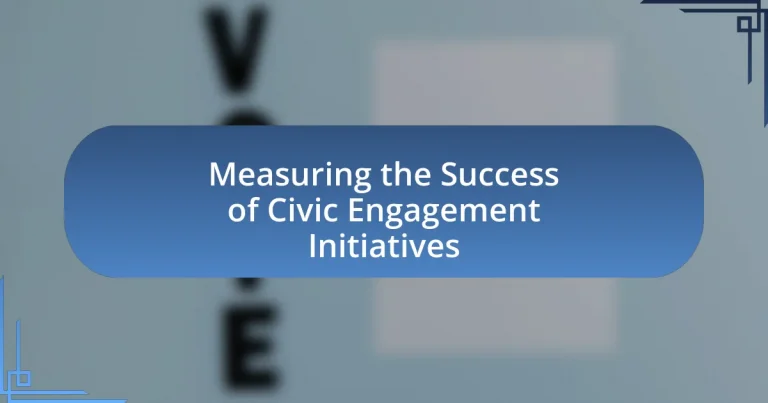Measuring the success of civic engagement initiatives involves evaluating the effectiveness and impact of programs aimed at enhancing public participation in governance and community activities. Key objectives include increasing participation, fostering collaboration, and promoting informed decision-making, with studies indicating that higher civic engagement correlates with improved governance and social cohesion. Common methods for measurement encompass both quantitative metrics, such as participation rates and survey responses, and qualitative insights from community feedback. Challenges in measurement arise from the lack of standardized metrics and varying definitions of success, while effective measurement can lead to informed decision-making for future initiatives, ultimately enhancing community engagement and trust.

What is Measuring the Success of Civic Engagement Initiatives?
Measuring the success of civic engagement initiatives involves evaluating the effectiveness and impact of programs designed to encourage public participation in governance and community activities. This measurement typically includes assessing participation rates, the quality of engagement, and the outcomes achieved, such as policy changes or increased community cohesion. For instance, a study by the National Civic League found that communities with higher civic engagement levels experienced improved local governance and enhanced public trust, demonstrating a direct correlation between engagement initiatives and positive community outcomes.
Why is it important to measure civic engagement initiatives?
Measuring civic engagement initiatives is important because it provides insights into their effectiveness and impact on community participation. By quantifying engagement levels, organizations can identify successful strategies and areas needing improvement. For instance, a study by the National Conference on Citizenship found that communities with higher civic engagement levels experience better governance and social cohesion. This data-driven approach enables stakeholders to allocate resources efficiently and enhance future initiatives, ultimately fostering a more active and informed citizenry.
What are the key objectives of civic engagement initiatives?
The key objectives of civic engagement initiatives are to enhance public participation, foster community collaboration, and promote informed decision-making. These initiatives aim to empower citizens by providing them with the tools and opportunities to engage in democratic processes, thereby increasing their influence on local governance and policy-making. Research indicates that communities with higher levels of civic engagement experience improved social cohesion and better public services, as evidenced by studies showing that participatory budgeting leads to more equitable resource allocation.
How do civic engagement initiatives impact communities?
Civic engagement initiatives positively impact communities by fostering increased participation in local governance and decision-making processes. These initiatives encourage residents to voice their opinions, leading to more representative and responsive policies. For example, a study by the National Civic League found that communities with active civic engagement programs experienced a 20% increase in voter turnout and improved public trust in local government. This demonstrates that civic engagement not only enhances democratic participation but also strengthens community bonds and promotes social cohesion.
What are the common methods used to measure success?
Common methods used to measure success in civic engagement initiatives include surveys, participation rates, and outcome assessments. Surveys gauge public opinion and satisfaction, providing quantitative and qualitative data on community perceptions. Participation rates track the number of individuals involved in initiatives, reflecting engagement levels and outreach effectiveness. Outcome assessments evaluate the impact of initiatives on community issues, often using metrics such as policy changes or improvements in social conditions. These methods collectively provide a comprehensive understanding of the effectiveness and reach of civic engagement efforts.
How do qualitative methods contribute to measuring success?
Qualitative methods contribute to measuring success by providing in-depth insights into participants’ experiences and perceptions. These methods, such as interviews and focus groups, allow researchers to capture nuanced feedback that quantitative data may overlook. For instance, a study on civic engagement initiatives found that qualitative feedback revealed community members’ motivations and barriers to participation, which were critical for understanding the effectiveness of the initiatives. This depth of understanding enables organizations to tailor their strategies, ultimately enhancing the impact and success of their civic engagement efforts.
What quantitative metrics are typically used?
Quantitative metrics typically used to measure the success of civic engagement initiatives include participation rates, survey response rates, and demographic diversity of participants. Participation rates quantify the number of individuals involved in initiatives, providing a clear indicator of engagement levels. Survey response rates reflect the effectiveness of outreach efforts and the willingness of participants to provide feedback, which is crucial for assessing the impact of initiatives. Demographic diversity metrics assess the inclusivity of the initiatives, ensuring that various community segments are represented, which is essential for equitable civic engagement. These metrics collectively offer a comprehensive view of the effectiveness and reach of civic engagement efforts.
What challenges are faced in measuring civic engagement success?
Measuring civic engagement success faces several challenges, primarily due to the complexity and variability of engagement itself. One significant challenge is the lack of standardized metrics, which makes it difficult to compare outcomes across different initiatives or communities. Additionally, civic engagement often encompasses a wide range of activities, from voting to community service, complicating the assessment of overall impact. Furthermore, qualitative aspects, such as individual motivations and community dynamics, are hard to quantify, leading to potential gaps in understanding the true effectiveness of engagement efforts. Research indicates that these challenges can result in inconsistent data and hinder the ability to draw meaningful conclusions about civic engagement initiatives.
How do varying definitions of success complicate measurement?
Varying definitions of success complicate measurement by creating inconsistencies in evaluation criteria. Different stakeholders, such as community members, organizations, and funders, may prioritize distinct outcomes, such as increased participation, improved community relationships, or policy changes. This divergence leads to challenges in establishing a unified metric for success, making it difficult to compare initiatives or assess their overall impact. For instance, a study by the National Civic League found that civic engagement initiatives often measure success through diverse lenses, resulting in varied interpretations of effectiveness and hindering comprehensive assessments.
What role does data availability play in measurement challenges?
Data availability is crucial in addressing measurement challenges because it directly impacts the accuracy and reliability of assessments related to civic engagement initiatives. When data is readily accessible, it enables stakeholders to evaluate the effectiveness of these initiatives through quantitative metrics, such as participation rates and demographic reach. Conversely, limited or poor-quality data can lead to misinterpretations of success, as seen in studies where inadequate data collection methods resulted in skewed outcomes, undermining the credibility of the initiatives. For instance, a lack of comprehensive data on community demographics can hinder the ability to tailor engagement strategies effectively, ultimately affecting the overall impact of civic programs.
How can we effectively transition from measurement to improvement?
To effectively transition from measurement to improvement in civic engagement initiatives, organizations should analyze collected data to identify specific areas needing enhancement. This involves using quantitative metrics, such as participation rates and feedback scores, alongside qualitative insights from community members to pinpoint strengths and weaknesses. For instance, a study by the National Civic League found that organizations that actively engaged with community feedback saw a 30% increase in participant satisfaction and engagement levels. By implementing targeted strategies based on this analysis, such as tailored outreach programs or improved communication channels, organizations can foster continuous improvement and better meet community needs.
What are the implications of successful measurement on future initiatives?
Successful measurement of civic engagement initiatives leads to informed decision-making for future projects. By analyzing data from previous initiatives, organizations can identify effective strategies and areas needing improvement. For instance, a study by the National Civic League found that communities that utilized data-driven approaches saw a 30% increase in citizen participation in subsequent initiatives. This evidence demonstrates that successful measurement not only enhances accountability but also fosters trust among stakeholders, ultimately guiding the design and implementation of more impactful future initiatives.
What specific indicators can be used to assess civic engagement initiatives?
Specific indicators to assess civic engagement initiatives include participation rates, volunteer hours, and survey responses measuring community satisfaction. Participation rates reflect the number of individuals involved in civic activities, indicating the initiative’s reach and effectiveness. Volunteer hours quantify the time invested by community members, showcasing commitment levels. Survey responses can provide qualitative data on community perceptions and the perceived impact of the initiatives, allowing for a comprehensive evaluation of civic engagement efforts. These indicators are essential for understanding the effectiveness and areas for improvement in civic engagement initiatives.
How do participation rates serve as indicators of success?
Participation rates serve as indicators of success by reflecting the level of community engagement and interest in civic initiatives. High participation rates demonstrate that initiatives resonate with the community, suggesting effective outreach and relevance of the programs. For instance, a study by the National Civic League found that communities with higher voter turnout and participation in local events often experience improved governance and stronger social cohesion. This correlation indicates that increased participation is not only a sign of success but also contributes to the overall effectiveness of civic engagement efforts.
What role does community feedback play in evaluation?
Community feedback plays a crucial role in evaluation by providing insights that reflect the perspectives and experiences of those directly affected by civic engagement initiatives. This feedback helps evaluators assess the effectiveness, relevance, and impact of programs, ensuring they align with community needs and expectations. For instance, studies have shown that incorporating community input can lead to improved program design and increased participant satisfaction, as evidenced by the National Civic Engagement Survey, which found that initiatives with strong community involvement reported higher success rates in achieving their goals.
What best practices should be followed when measuring success?
To effectively measure success in civic engagement initiatives, it is essential to establish clear, measurable objectives from the outset. These objectives should align with the overall goals of the initiative, allowing for specific metrics to be identified, such as participation rates, community feedback, and changes in public policy. Utilizing both qualitative and quantitative data enhances the evaluation process; for instance, surveys can provide insights into participant satisfaction while statistical analysis can quantify engagement levels. Regularly reviewing and adjusting these metrics based on feedback and outcomes ensures that the measurement process remains relevant and effective. Research indicates that initiatives with defined metrics and ongoing evaluation demonstrate a 30% higher likelihood of achieving their intended outcomes, as shown in studies conducted by the National Civic League.


